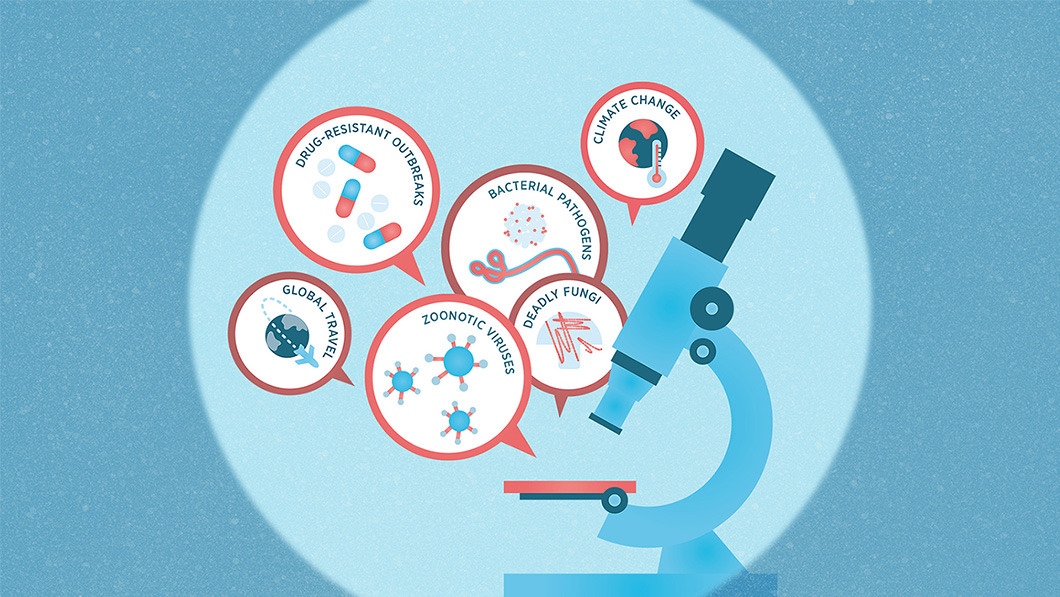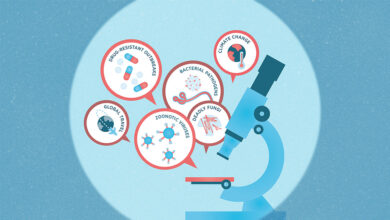
Vaccine urgency, doom scenarios and Neanderthal herpes
Sponsored by:

PPF: Health Security
PPF’s report The Next One: Preparing Canada for another health emergency outlines the lessons learned from the pandemic and how Canada can safeguard against future health emergencies. To keep the discussion going — and to keep Canadians informed — this newsletter looks at what’s happening in the world of health security each week. Here’s what we’re following:
New vaccine urgency
A young child died of measles in Ontario, the first person to succumb to the infectious disease in the province since 2013. Public Health Ontario (PHO) reports 22 cases so far this year in Ontario, compared to seven in all of 2023, one in 2022, and zero in 2020 and 2021. Cases of the extremely contagious respiratory virus are rising around the world. Canada is not exempt, despite having eliminated endemic transmission of the disease in 1998. Vaccine hesitancy and complacency may carry responsibility for the surge, but an equally likely culprit: COVID-19 lockdowns, which interrupted the normal vaccine schedule for many kids. In Canada, children typically receive the measles, mumps and rubella (MMR) vaccine at between 12 and 15 months, and the second between 18 months and school age. The child who died was not immunized, according to PHO. A new study led by the World Health Organization (WHO) published in The Lancet pegged the number of lives saved by vaccinations since 1974 at 154 million people globally, the vast majority of which — some 146 million — were children younger than five. The study further asserted that vaccinations against 14 diseases (including measles) has played a “pivotal” role in reducing infant mortality by 40 per cent in that same period. The release of these numbers, combined with the worrying spike in measles, lends gravity to the recent directive of Kate O’Brien, Director of the Department of Immunization, Vaccines and Biologicals at WHO. In a message last week, O’Brien called for those attending the World Health Assembly in Geneva later this month to take “urgent action” in pursuit of Immunization Agenda 2030, a plan that aims to halve the number of children with no vaccination in the next six years. “Intensified efforts are needed to reach millions of children in humanitarian settings, often the most vulnerable and underserved,” O’Brien stated. “Innovative approaches and robust partnerships will be crucial in reaching these unreached populations and ensuring equitable access to life-saving vaccines.”
KP.2 overtakes JN.1
KP.2, the latest of the so-called FLiRT variants of COVID-19, is on track to become the strain of the summer, jumping from four per cent of all U.S. cases in late March to 28 per cent by early May. KP.2 is quickly overtaking JN.1, which has been the dominant variant in the U.S. throughout 2024 so far. What do you need to know? Not much you don’t already know, at this stage. While KP.2 is very similar to JN.1, those who contracted the former are not necessarily protected against the latter — especially if it’s been a few months. Still, experts contend there’s no need to panic. Only trace amounts of the virus are being found in wastewater across the U.S., and hospitalizations related to COVID are on a downward trend. “I don’t want to say that we already know everything about KP.2,” Dr. Ziyad Al-Aly, the chief of research and development at the Veterans Affairs St. Louis Healthcare System, told the New York Times. “But at this time, I’m not seeing any major indications of anything ominous.”
Health care doom scenarios
A new report by Policy Horizons Canada outlines a set of 35 plausible — and mostly grim — scenarios that might or might not disrupt life as we know it. The report includes several potential crises with implications to health security, including near-total system failure: “The health-care system could deteriorate to the point of collapse, becoming unable to meet the daily needs of Canadians, let alone respond to emerging crises,” the report reads. Existing pressures (including our aging population, increased rates of degenerative diseases, and limited funding) could butt up against new ones (antimicrobial resistance, biological threats, and — stay with us here — augmented humans) to strain the system beyond its capabilities, the authors contend. “If Canadians cannot count on reliable access to effective health care, there may be increased mortality rates, distrust in fundamental government services, damage to Canada’s global reputation, impacts to immigration, and social upheaval.” Other no-good, very-bad health possibilities flagged in the report relate to ecosystem collapse caused by biodiversity loss (“Health and wellbeing could severely suffer as malnutrition, disease, and other health problems become more prevalent”), overwhelmed emergency response systems (“An already fragile healthcare system may crumble under surging demand”), and downward social mobility (“As people lose hope in improving their lives, mental health challenges and associated economic and social stresses may increase.”).
Superbug threats
While we’re on the topic of dire warnings, a major U.K. public health figure is sounding the alarm about a potential surge in drug-resistant superbugs. Speaking with The Guardian, Sally Davies, England’s former chief medical officer and the U.K.’s current special envoy on antimicrobial resistance, stressed the increasing threat caused by new infections that are impervious to available medicines. Antimicrobial resistance is estimated to kill 3,500 people worldwide each day — a situation Davies says may quickly spiral into a future of untreatable infections and intensive isolation of sick people. “So it’s a really disastrous picture,” Davies said. “It would make some of COVID look minor.” Davies goes on to call on public health officials, scientists and other stakeholders to accelerate the development of new treatments. “If we haven’t made good strides in the next 10 years, then I’m really scared,” she said.
Climate change and kids’ health
As Canadians gird ourselves for another summer of rampant wildfires and record heat there’s new evidence that climate change represents a significant — and growing — threat to public health. This year’s wildfire season has already resulted in more than 320 air quality alerts in Alberta alone, including 14 with an Air Quality Health Index of 10+, which confers a very high health risk. The mandates of public health officials now include managing wildfire-related human health risks. The Canadian Climate Institute projects the costs of heat-related deaths and reduced quality of life at up to $4 billion annually by the middle of the century. New evidence is showing the effects of all this hot air on the youngest Canadians. A report by ParticipACTION released earlier this month reveals that just 39 per cent of Canadian children and youth get at least 60 minutes of heart-pumping physical activity a day — lagging behind more than two dozen countries — and our hotter, smokier atmosphere is a big reason. “With already low grades for children’s physical activity, climate change is emerging as a new barrier for children and youth to get more active,” a trio of researchers behind the ParticipACTION report write in The Conversation, pointing out that increased instances of wildfire smoke, heat domes and scorching weather lead to cancelled recesses, sports events and school days — all of which results in less movement and more health risks: “Children, compared to adults, are also more vulnerable to climate-related weather events based on their smaller airways and need to breathe more rapidly, which could put them at greater risk of inhaling more pollutants and subsequent lung diseases.” The report suggests caregivers replace sedentary and screen time with indoor active play during climate events.
Neanderthal herpes
Scientists in Brazil have isolated the genetic sequences of three of today’s most common viruses — herpesviruses (the cause of cold sores), papillomavirus (the sexually transmitted infection HPV) and adenovirus (the common cold) — from the 50,000-year-old remains of Neanderthals found in a Siberian cave. Researchers hope to synthesize and test these viruses to see how they compare to modern equivalents, and to better understand how disease affected our ancient cousins.
Events
May
- May 13-16: AAPS 2024 National Biotechnology Conference. San Francisco, CA.
- May 13-17: PEGS Boston. Boston, MA
- May 14-16: CAHSPR 2024. Ottawa, ON.
- May 16: US Pharma and Biotech Summit. NYC, NY
- May 16: STAT Breakthrough Summit West. San Francisco, CA.
- May 27-June 1: World Health Assembly. Geneva, Switzerland.
June
- June 3-6: Bio International Convention. San Diego, CA.
- June 12-13: The Festival of Genomics & Biodata. Boston, MA
- June 30-July 3: European Congress on Biosecurity. Rotterdam, Netherlands.
Did someone forward you this newsletter? Subscribe to PPF: Health Security newsletter
This newsletter is produced by journalists at PPF Media. It maintains complete editorial independence.



